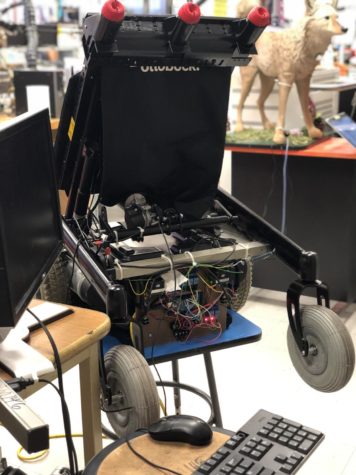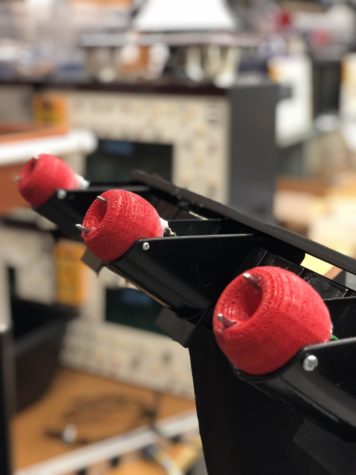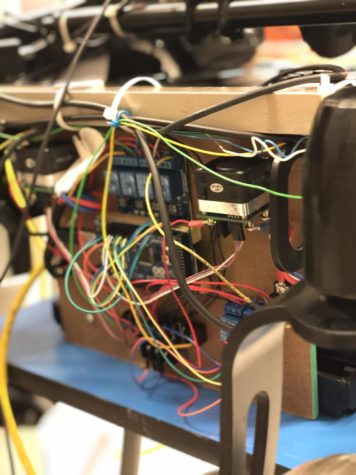We Can Stop School Shootings… With A Robot.
March 20, 2019
A little over a year has now passed since the Parkland school shooting, but the gravity of the tragedy has not diminished in any way. The shooting continues to affect people within and beyond Parkland, Florida. It has particularly afflicted BCA student Mariem Ahmad (ATCS 2021).
Emotionally struck by the Parkland school shooting, Mariem wanted to do something. After two trimesters, Mariem-along with ATCS sophomores Audrey Kim, Teva Alon, Melissa Ozcan, and senior interns Max Hayashi (ATCS) and Marek Chmielewski (ABF)-may have just created the very thing this country needs to prevent school shootings f rom happening again: a sentinel robot. It rests in Mr. Nodarse’s room, ready for action. Mr. Nodarse noted, “The robot was not made to stop the shooter but at least to occupy him. We need something that has a presence.”
rom happening again: a sentinel robot. It rests in Mr. Nodarse’s room, ready for action. Mr. Nodarse noted, “The robot was not made to stop the shooter but at least to occupy him. We need something that has a presence.”
At the beginning of her sophomore year, Mariem began playing with ideas: A ball launcher? A taser? We need to confront the intruder… but who would be willing to do that? We don’t want anyone to get hurt… Do we use AI? Wifi? Tether control?
Working with Mr. Nodarse, the ACTS girls decided to make a robot controlled by wifi. 11 years ago in 2008, a group of students in ATCS had actually made a robot controlled by wifi, but electronics were quite antiquated at the time, preventing the robot from executing complex tasks.
The project began with a salvaged wheelchair. BCA was fortunate enough to receive it. Mariem spent the first trimester of this year stripping down the wheelchair to is basic elements. She spent a lot of time putting the wheelchair together (into the form blueprinted), making hardware adjustments, and preparing the three built-in tasers that would be part of the completed robot.
Second trimester, Teva Alon joined the team and began working on the software interface. Thanks to Teva, it was possible to dial into and drive the robot through a cell phone application. The remote control system on the cell phone was eventually moved to a table remote control. The robot, when completed would be used by police officers, not students, teachers, nor administrators, so it would not be practical to have the robot’s control system on a personal cell phone.
Melissa Ozcan soon joined the effort and started to set up the mechanical systems of the robot. Audrey Kim then began developing the hardware interface between the wheelchair
 and the microcontrollers (in layman’s terms, the remote control) using Raspberry Pi and Arduino. Senior Wednesday interns Max and Marek assisted with the electronics of the wheelchair that enable it to go forward, backward, make left and right turns, and go into reverse mode.
and the microcontrollers (in layman’s terms, the remote control) using Raspberry Pi and Arduino. Senior Wednesday interns Max and Marek assisted with the electronics of the wheelchair that enable it to go forward, backward, make left and right turns, and go into reverse mode.
The robot itself can be understood in 4 tiers. Tier 1 is the driving system. This system controls the movement of the wheels. Tier 2 features “shield mode,” which can be used to forcefully push someone. Tier 3 is “ram mode.” Tier 4 is “taser mode,” which utilizes the 3 red tasers of the wheelchair to attack an intruder anywhere from the lower body (i.e. the legs) to the upper body (i.e. the stomach).
Despite how incredible the robot already is, Mr. Nodarse notes that there are certainly improvements to be made. His team plans on creating a claw for the wheelchair such that it can open and close doors (currently, the robot can only move through hallways). They also plan on creating a system that would allow the robot to move up and down stairs.
The robot itself is an impressive sight, but its statement is most important. Mr. Nodarse shared: “It was a lot of work, a lot of hours, and quite honestly, it is a huge project that should have taken two years. Nonetheless, this project shows what a small research program with just a handful of high school students can do. It was extraordinary six students interacting together to accomplish a single goal. We just used recycled electronic equipment… what could a reputable robotic company that possesses unlimited
 resources do? Perhaps the federal government can put money aside in the education budget to put robots like this one in all schools in America. That way, it will be like having the police with us at all times of the school day, every day.” Thus the robot isn’t just a remarkable piece of technology; it was created with meaning. Mr. Nodarse said, “The story here is of students being proactive and seeing the Parkland incident and what it created. They sensed the insecurity, the fear building in both students and parents asking, ‘When is it going to be my turn?’ ‘When will this happen to us?’ They took action. If these are students and they can make something as remarkable as this, we should be asking ourselves what the government can do to reproduce this project for all of the schools in the country and protect its students.”
resources do? Perhaps the federal government can put money aside in the education budget to put robots like this one in all schools in America. That way, it will be like having the police with us at all times of the school day, every day.” Thus the robot isn’t just a remarkable piece of technology; it was created with meaning. Mr. Nodarse said, “The story here is of students being proactive and seeing the Parkland incident and what it created. They sensed the insecurity, the fear building in both students and parents asking, ‘When is it going to be my turn?’ ‘When will this happen to us?’ They took action. If these are students and they can make something as remarkable as this, we should be asking ourselves what the government can do to reproduce this project for all of the schools in the country and protect its students.”






